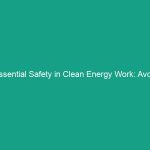Introduction
Good morning team! Today, we are going to discuss a crucial topic that affects all of us: Must-Know Tornado Safety Guidelines. Understanding and implementing these guidelines is vital for protecting yourself and your colleagues during tornado events. Tornadoes can occur unexpectedly, and knowing how to respond can save lives and prevent injuries.
Understanding Tornado Safety Guidelines
Tornado Safety guidelines are a set of Best Practices designed to help individuals respond effectively to tornado threats. These guidelines are important because tornadoes can cause significant destruction and pose serious risks to life and property. By being prepared and knowing how to act, we can minimize these risks and ensure a safer workplace.
Many employees may think that tornadoes are a rare occurrence or that they won’t happen in their area. This misconception can lead to a lack of preparedness, making it crucial for us to remain vigilant and informed. Let’s break down the key aspects of tornado safety.
Key Hazards, Risks, and Safety Considerations
Tornadoes present several Hazards, including high winds, debris, and potential structural collapses. Ignoring tornado safety protocols can lead to severe injuries or fatalities. Here are some specific risks associated with tornadoes:
- High Winds: Tornado winds can exceed 200 mph, which can easily toss vehicles and debris, posing a severe threat to anyone caught outside.
- Flying Debris: Objects picked up by tornado winds can become lethal projectiles.
- Structural Collapse: Buildings, especially those not designed to withstand high winds, can collapse during a tornado.
Ignoring these risks can have real-world consequences. For instance, during a recent tornado outbreak, several employees were injured due to a lack of awareness and preparation, which could have been avoided by following safety guidelines.
Best Practices, Procedures, & Actionable Advice
To stay safe during a tornado, follow these step-by-step safety Procedures:
1. Stay Informed
Always keep an eye on weather forecasts, especially during storm seasons. Utilize weather apps or NOAA weather radios to receive alerts about impending tornadoes.
2. Have a Plan
Develop a tornado action plan that includes:
- Designated shelter areas in your workplace (interior rooms, basements, or specially designed storm shelters).
- Clear evacuation routes and procedures.
- A communication plan to ensure everyone is accounted for.
3. Practice Drills
Regularly conduct tornado drills to ensure everyone knows the procedures. Practice makes perfect and can significantly reduce panic during an actual emergency.
4. During a Tornado Warning
If a tornado warning is issued:
- Seek shelter immediately in your designated area.
- Stay away from windows and doors.
- Protect your head and neck with your arms or a sturdy object.
5. After the Tornado
Once the tornado has passed, remain in your shelter until it is safe to exit. Check for injuries and report any hazards (like downed power lines) to authorities.
Case Study
In 2011, a tornado struck Joplin, Missouri, resulting in over 150 fatalities. Investigations revealed that many victims were unprepared and did not follow safety protocols. This tragic event underscores the importance of being proactive about tornado safety in our workplaces.
Regulations, Standards, and Compliance
Compliance with safety Regulations is crucial to protect employees during tornado events. OSHA (Occupational Safety and Health Administration) does not have specific tornado regulations, but it mandates employers to provide a safe working Environment. This includes:
- Conducting risk assessments to identify potential hazards.
- Implementing emergency action plans.
- Training employees on emergency procedures.
Following these guidelines not only keeps employees safe but also ensures compliance with broader safety regulations.
Employee Engagement & Discussion
Let’s take a moment to reflect on our experiences. What safety challenges have you encountered related to tornado preparedness? How can we improve our current procedures? Your input is invaluable in creating a safer workplace.
Conclusion & Key Takeaways
In summary, understanding tornado safety guidelines is essential for protecting ourselves and our co-workers. Remember to stay informed, have a clear action plan, practice your drills, and follow safety procedures during and after a tornado.
By prioritizing these Safety Measures, we can create a safer work environment and ensure everyone’s well-being. Thank you for your attention and commitment to safety. Let’s work together to keep our workplace safe!


